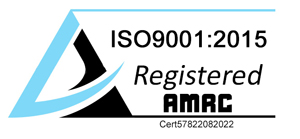The Extrusion Process
Cooling the extrusion
Temperature plays a vital role in the second part of the extrusion process. Firstly, the aluminium leaving the die has to maintain an optimum temperature to ensure the press continues to run smoothly. Once again, this temperature varies dependent on the aluminium alloy content or purity, but should be around 950°C.
Secondly, the newly shaped profile is fed down a run-out table which is lined with fans, the purpose of which is to begin the cooling or ‘tempering’ process. Some variations of alloy are cooled using liquids as well as air cooled. When the extrusion reaches a specific length, the press blade cuts it off and is carried off to the cooling table where the long sections of profile are stacked in preparation for the next stage.
Stretching to straighten
‘The Stretcher’ consists of a jawed gantry that the long sections of aluminium are fed on to, the jaws are at opposing ends of the gantry and grip the now cooled (and hardened) profile, applying a controlled force that stretches the aluminium. The main purpose of which is to straighten the curved extrusion, however the process also has a minor effect on the molecular alignment within the metal, giving improved strength and hardness – which has a knock-on effect to its mechanical properties and applications.
The final chapter – Cutting and ageing
The extrusions exit the stretching process at varying lengths, governed by the facilities of each particular extrusion plant, but they can measure up to fifty metres long. They are fed into the saw conveyor where they are cut to the customers required length. Specifications in length are also variable dependent on the profiles intended application or industry, but generally range from two to six metres.
Ageing is the final stage of the extrusion process before dispatch to the customer, different alloys have their own measured, corresponding EN/GB standards of strength to achieve and the ageing process ensures these standards are met. The extrusions are heated in ovens over a four to eight hour period in the temperature range of 170°C – 190°C, resulting in a superior product that is ultimately more reliable.
Experienced Designers & Manufacturers
We create aluminium profiles and extrusions, designed and manufactured especially to suit your requirements. Contact our team today to arrange a quote and see how our service can help your business.
Flexible Volumes of Product
For one of pieces or larger bulk order, simply get in touch with our team today to get the ball rolling and start our bespoke design process.


